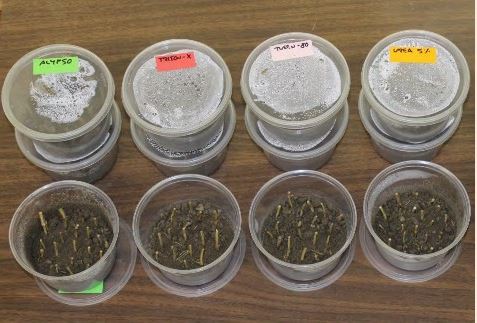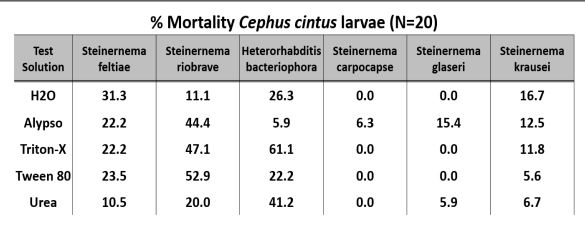Evaluations of six species of entomopathogenic nematodes and four carrier solutions for use in the management of wheat stem sawfly larvae, Cephus cintus (Hymenoptera: Cephidae)
Principle Investigators: Dr. Gadi VP Reddy and Dr. David K. Weaver Cooperators: Dr. Scott L. Portman and Amber Ferda
Montana State University,
Western Triangle Agricultural Research Center,
Conrad MT, 59425
Background:
Three species of entomopathogenic nematodes (EPNs) have been shown to possess the ability to infect and kill the larvae of wheat stem sawfly (Cephus cintus). However, the biology of these three species of nematodes (generally prefer warm moist climates) may not be suitable for use in the State of Montana where the climate is cooler and dry. Species that are active at temperatures <15 oC (avg. fall temperature in NW Montana) and more tolerant to dryer conditions could be more effective at controlling sawfly. In addition, sawfly larvae are insulated inside the hollowed out wheat stems and therefore not readily exposed to soil dwelling natural enemies such as EPNs. One mode of entry from EPNs into the wheat stem might be through the plug that sawfly larvae construct to block the opening of the girdled wheat stem. However, the plug is very hydrophobic; therefore, water does not soak into the plug easily. The exact composition of the plug is unknown but it is thought to be constructed of larval frass and plant material. Wetting agents such as ionic solutions, detergents or surfactants may function better at soaking into the plug, thus acting as a carrier solution for EPNs.
Objectives:
-
-
Test six different species of EPNs for their ability to penetrate into the stem and kill the sawfly larva.
-
Test four different solutions for their ability to penetrate the plug and function as a carrier solution for EPNs.
-
Materials and Methods:
In September and October, 2015, wheat stem stubble containing sawfly larvae was collected from several field sites in Pondera County, NW Montana. Wheat stubble was stored in clean 475 ml deli cups at 8oC. Just before treatment, stubble was inserted individually into deli cups containing approximately 2.5 cm of autoclaved soil (Fig. 1). Each deli cup contained 15-20 individual wheat stems.
Figure-1: Deli cups with wheat stubble harboring sawfly larvae. Deli cups are filled with ≈2.5 cm of autoclaved soil. Roots were trimmed back and wheat stems were pushed into the soil until the soil covered the remaining roots.
Solutions of four different wetting agents (0.1% Triton-X, 0.1% Tween 80, 0.3% Alypso, 5.0% Urea, and distilled water) were prepared in the lab and stored at 8oC. Alypso® is a commercially available soil surfactant (Precision Laboratories, Waukegan, IL) and was prepared according the manufacturer’s instructions (0.3%). Trition-X and Tween 80 (Sigma-Aldrich, St. Louis MO) are mild detergents commonly used in washing buffers or cell lysis buffers by molecular biologists. Solutions of both Triton-X and Tween 80 were prepared according to concentrations found in molecular biology protocols (0.1%). Urea (Sigma-Aldrich, St. Louis MO), a highly ionic compound, was tested at different concentrations for EPN survival (1%, 5%, 10%). EPNs were able to tolerate both 1% and 5% urea. The 5% concentration was chosen as a treatment because the 5% solution soaked into the plug material faster than 1% solution. Distilled water was used as a control.
Six species of commercially available EPNs (Steinernema carpocapse, S. feltiae, S. glaseri, S. krussei, S. riobrave, and Heterorhabditis bacteriophora) were ordered from suppliers and stored at 8oC. EPNs were allowed to equilibrate to room temperature (22oC) before being added to 3ml of each wetting solution. Wetting solutions containing EPNs were first mixed thoroughly and sucked up into a disposable pipette. Solutions were applied to the wheat stems by placing a single droplet on top of the stem’s plug. After solution application, treated stems were incubated at 20oC in a growth chamber for 7 days. After 7 days, the larvae were extracted from the stems and assayed for nematode infection. Larvae that appeared healthy larvae were placed in small 60 ml deli cups and observed for latent signs of nematode infection.
Results and Discussion:
Initial experiments indicated that only three of the six species of EPNs produced significant sawfly mortality (>30%): H. bacteriophora, S. riobrave, and S. feltiae (Table 1). Thus the three underperforming species (S. carpocapse, S. glaseri, and S. krausei) were eliminated from subsequent trials.
Table 1 Values represent percent mortality rates of sawfly larvae (Cephus cinctus) obtained from infested wheat stubble treated with six species of entomopathogenic nematodes, combined with five different carrier solutions.
To obtain sufficient sample sizes, the experiment was replicated four times. For each replication, mortality rates for all treatment combinations (solutions × nematodes) were calculated. Mortality rates were treated as independent observations in the data analysis. On average, Triton-X combined with H. bacteriophora, and S. riobrave produced the highest mortality rates (64.7% and 42.1% respectively). Two-way analysis of variance (ANOVA) was used compare differences in mortality rates among the treatments. The ANOVA model included “nematode species”, “treatment solution”, and “nematode × treatment” interaction term as predictor variables. Post-hoc multiple comparison procedure (Dunnett’s Test) was used to determine if there were any differences in mortality rates for carrier solutions vs. controls (distilled H2O).
Analysis (ANOVA P=0.048, R2 =0.49) showed significant effects from “treatment solution” (P=0.039) but not “nematode species” (P=0.457). The interaction term was marginally insignificant (P=0.063); however, post-hoc analysis of the interaction term indicated that Triton- X combined with either H. bacteriophora, or S. riobrave produced significantly higher mortality than the control solution (P=0.006 and P=0.023, respectively; Fig. 2).
Figure-2: Bars represent mortality rates of sawfly larvae (Cephus cinctus), obtained from infested wheat stubble, treated with three species of nematodes, combined with five different carrier solutions. Asterisks show significant differences (P<0.05) in mortality compared to distilled water treatment (control).
Overall these results suggest that Trition-X might function as carrier solution that would allow EPNs to enter infested wheat stems and kill the sawfly larvae inside, particularly when they are combined with H. bacteriophora, or S. riobrave. The results using S. riobrave are encouraging because this species is relatively tolerant of cold and dry conditions -similar to conditions found in NW Montana in the fall (post harvest). One limitation of this study is that these results were obtained under very controlled laboratory conditions and cannot be extrapolated to effects obtained under field conditions. However, more experiments are planned for 2016 to test these treatments under field conditions. In the interim, more replications can be obtained and new solutions can be tested in the laboratory.
Acknowledgements
Funding for this research is provided by Montana Wheat and Barley Committee.



